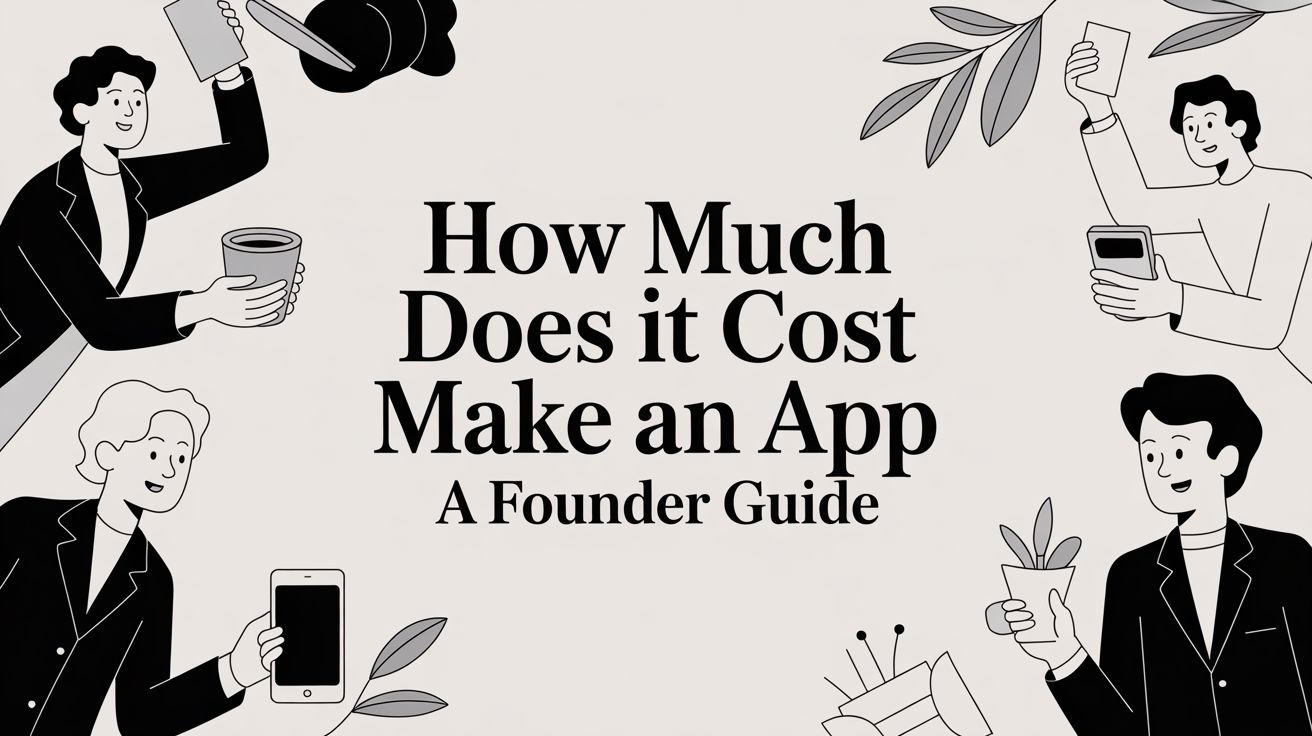So, you’ve got a brilliant app idea buzzing in your head. Awesome! Now for the big question every founder asks right out of the gate: what’s the price tag?
Answering "how much does it cost to make an app?" is a bit like asking how much a car costs. A simple, reliable runaround will set you back a lot less than a custom-built, high-performance sports car. The same logic applies here.
To give you a straight answer, a simple app in the UK can start from around £10,000. But for something complex and packed with features, that figure can easily climb north of £150,000.
Your App Idea Is Brilliant, But What’s The Price Tag?
You've got a fantastic idea, and that’s the most exciting part! But let's get practical – turning that spark into a fully functioning product that people love requires a solid financial game plan. For experienced founders, getting a grip on potential costs from the start is absolutely vital for allocating resources smartly and setting realistic fundraising targets.
Think of your app's budget as a spectrum. At one end, you have the Minimum Viable Product (MVP). This is the lean, essential version of your app, designed to get you into the market quickly, test your core assumptions, and see if your idea has legs. At the other end, you have a full-blown, feature-rich product ready to handle a massive user base. Where your project lands on this spectrum will directly shape your investment.
UK App Development Cost At a Glance
To give you a clearer picture, let's break down some typical costs you might see here in the UK. The investment needed is tied directly to the complexity of what you want to build.
- Think basic user login, simple lists, and static content.
- This level includes a custom UI/UX, integrations with other services (APIs), and user profiles.
- Here you’re looking at advanced features like AI, e-commerce, and real-time data synchronisation.
As you can see, the more you want your app to do, the more resources it will require. This is a good thing; it just means you need a strategic plan for what to build first.
This bar chart gives you a great visual breakdown of how project complexity impacts the budget.
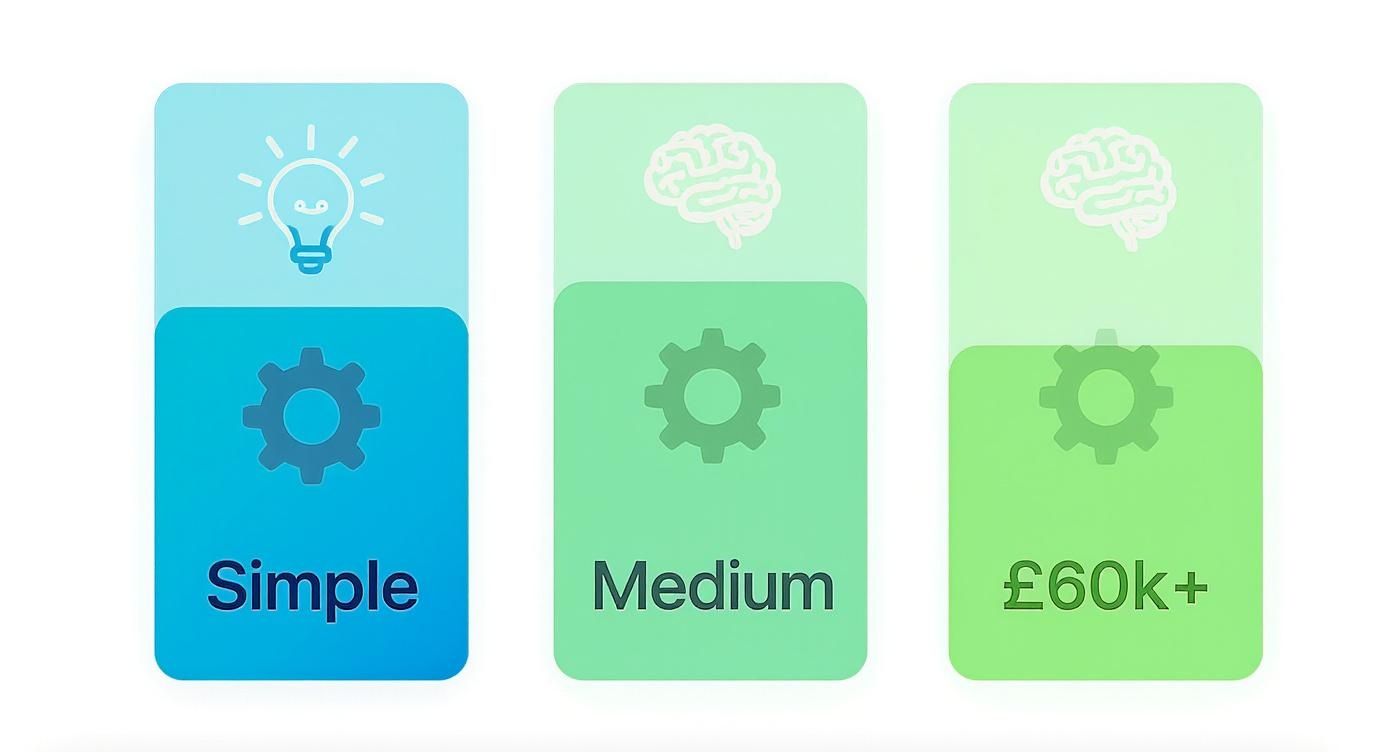
The key takeaway? Your costs will scale directly with complexity. This is actually good news, as it lets you align your initial build with your immediate goals and current funding, without having to build everything all at once.
A realistic budget is the launchpad for your entire project. It drives your fundraising strategy, defines your product roadmap, and ultimately determines how you bring that brilliant vision to life.
For a deep dive into the whole journey, check out our guide on how to create an app from start to finish. It’s all about making smart moves from day one to get everyone ‘appy. 🤓
The Core Factors That Shape Your App Budget
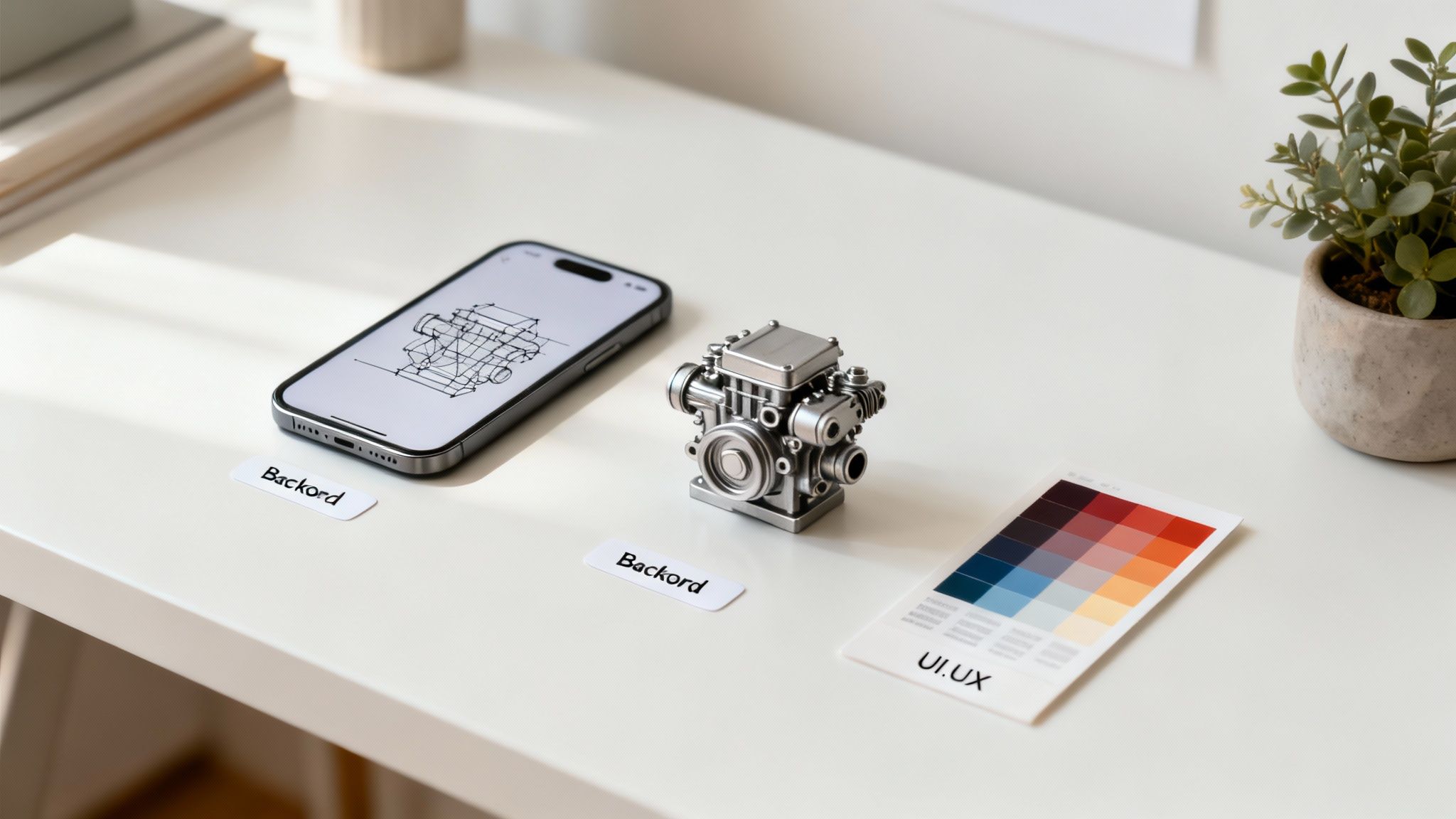
So, what really goes into the final price of an app? It's less like buying something off the shelf and more like commissioning a custom-built car. Every single decision, from the engine roaring under the hood to the exact shade of paint, shapes the final cost.
Getting a handle on these core drivers is the first step to building a realistic budget and a product roadmap you can actually stick to. Let's pop the hood and take a look at what truly shapes your investment.
Platform and Device Support
One of the first big forks in the road is deciding where your app will live. Are you chasing the millions of iPhone users on iOS, the massive global market on Android, or are you going for both?
Building natively for each platform—that’s one app for iOS and a completely separate one for Android—almost always delivers the slickest performance and the best user experience. The catch? You're essentially funding two separate projects, which can nearly double your development costs right out of the gate.
The alternative is to use a cross-platform framework like React Native or Flutter. This route lets your team build from a single codebase that runs beautifully on both iOS and Android. It’s a fantastic way to slash upfront costs and get to market much faster. Honestly, the right choice boils down to what your product needs to do and where you see it going long-term.
Feature Complexity and Scope
Okay, this is the big one. The gulf between a simple login screen and a real-time, AI-powered recommendation engine is absolutely massive, both in technical difficulty and budget. Every feature you add piles on more hours of design, development, and crucial testing.
A few things that can really crank up the complexity include:
- User Authentication: A simple email and password login? Fairly straightforward. But adding social logins (think Google or Apple) or multi-factor authentication adds significant layers of work.
- Third-Party Integrations: Need to hook into a payment gateway like Stripe, pull in data from Google Maps Platform, or sync with other tools? Each of these integrations needs to be carefully wired in and tested from every angle.
- Backend Infrastructure: This is the engine room of your app. A simple product might get by with a basic database. A more ambitious one could demand custom server architecture, multiple databases, and sophisticated APIs to handle a flood of users and data.
Actionable Advice: Be ruthless about your MVP's feature set. Ask yourself: what is the bare minimum we need to solve our user's biggest problem? Everything else is just noise for now.
UI/UX Design and Polish
Let's be clear: brilliant design isn't just about making things look pretty. It's about crafting an experience that feels effortless, intuitive, and frankly, makes people happy to use your app. A polished User Interface (UI) and a thoughtful User Experience (UX) can be the single biggest difference between an app people tolerate and one they genuinely love.
This process has a few key stages:
- Wireframing: This is where we sketch out the basic blueprint and flow of the entire app.
- UI Design: Now we bring it to life, crafting every visual element from buttons and icons to colour palettes and typography.
- Prototyping: We build interactive mockups to test the entire user journey before a single line of code gets written.
- Animations: Adding those slick custom transitions and micro-interactions that make the app feel alive and responsive.
Sure, you can use standard design templates to keep a lid on costs. But a bespoke, beautifully polished design—while requiring more time from skilled designers—is what truly makes a product stand out and leaves a lasting impression.
Maintenance and Non-Functional Requirements
Finally, and this is something too many people forget, launching your app is just the beginning of the journey. Your app is a living thing, and it needs ongoing care to stay healthy, secure, and relevant.
Actionable Advice: As a rule of thumb, you should budget 15-20% of the initial development cost annually for maintenance. This covers all the essentials: fixing bugs, server upkeep, and crucial updates to keep up with new operating systems (like the yearly iOS and Android releases).
Beyond that are the "behind-the-scenes" heroes known as non-functional requirements. These are the things that ensure your app is fast, secure, and can handle growth. They're vital for any professional product. You can dive deeper into these critical elements in our guide to understanding non-functional requirements. Thinking about these from day one is how you build an app that’s made to last.
Choosing The Right Development Team For Your Budget
So, who’s actually going to build this masterpiece with you? This decision is one of the biggest levers you can pull on your budget. Working out how much it costs to make an app is completely tied to the team you get on board to bring it to life.
As a founder, you've got a few solid paths to choose from. Each has its own vibe, cost structure, and set of trade-offs. Let's break them down so you can find the perfect match for your vision and your wallet.
Traditional Agencies
Think of a traditional agency as an all-inclusive resort. They give you the full, end-to-end service, handling everything from strategy and design right through to development, testing, and launch. It’s a very hands-off approach, which can be brilliant if you have the funding but are too strapped for time to manage the project day-to-day.
The catch? That premium, all-in service comes with a premium price tag. Their overheads are usually higher, and you might find their processes a bit more rigid and less collaborative than you’d like.
Product Studios and Launchpads
This is where we live! A product studio or Launchpad model, like ours here at AppyCamper, is built specifically for founders. We jump in as your strategic technical co-founder, becoming a genuine part of your team. The goal isn't just to take orders; it's about challenging your assumptions, honing a razor-sharp MVP, and launching it efficiently on a fixed timeline.
It’s a super collaborative, high-energy approach designed to get you to market, fast. The cost is often far more predictable than other models because we lock down the scope from the get-go, making everyone ‘appy with a clear financial roadmap. 🤓
Freelance Squads
Hiring a team of freelancers gives you incredible flexibility. You can hand-pick specialists for every single part of the project—a UI designer from one place, an iOS developer from another, and a backend engineer from somewhere else entirely. This model can be seriously cost-effective, especially when you tap into the global talent pool.
The big challenge here is the management. You become the project manager, and you’re responsible for coordinating everyone, making sure the quality is there, and keeping the whole project on track. It demands a huge time investment and a decent amount of technical know-how to pull it off smoothly.
Building an In-House Team
Bringing your developers in-house gives you the ultimate control and a long-term investment in your product. Your team will live and breathe your vision every single day. For well-funded companies that are ready to scale, this is often the end goal.
But—and it’s a big but—it is by far the most expensive and time-consuming route right out of the gate. You're not just paying salaries; you're also covering recruitment costs, benefits, equipment, and all the other overheads that come with having full-time employees. It’s a marathon, not a sprint.
Actionable Advice: The best development partner isn’t just a group of coders—they’re an extension of your team. They should be just as excited about your idea as you are and have the skills to challenge, guide, and build it into something incredible.
How Location Impacts Your Costs
Where your team is based plays a massive role in the final bill. Developer rates vary wildly around the world, and even just within the UK, you’ll see some significant differences.
Regional cost disparities are a huge factor for UK founders. For instance, apps developed in London can be around 25% more expensive than those built by regional or hybrid teams. A two-sided marketplace app might cost about £94,000 when developed in central London, versus £57,000 with a UK project manager leading developers based in Poland. You can explore more detailed UK cost breakdowns and see how geography influences app development budgets.
This doesn't mean you should automatically outsource everything to the cheapest location. A hybrid model, which combines local strategic oversight with global development talent, often strikes the perfect balance between cost-efficiency and quality control.
Real World App Budget Scenarios For UK Founders
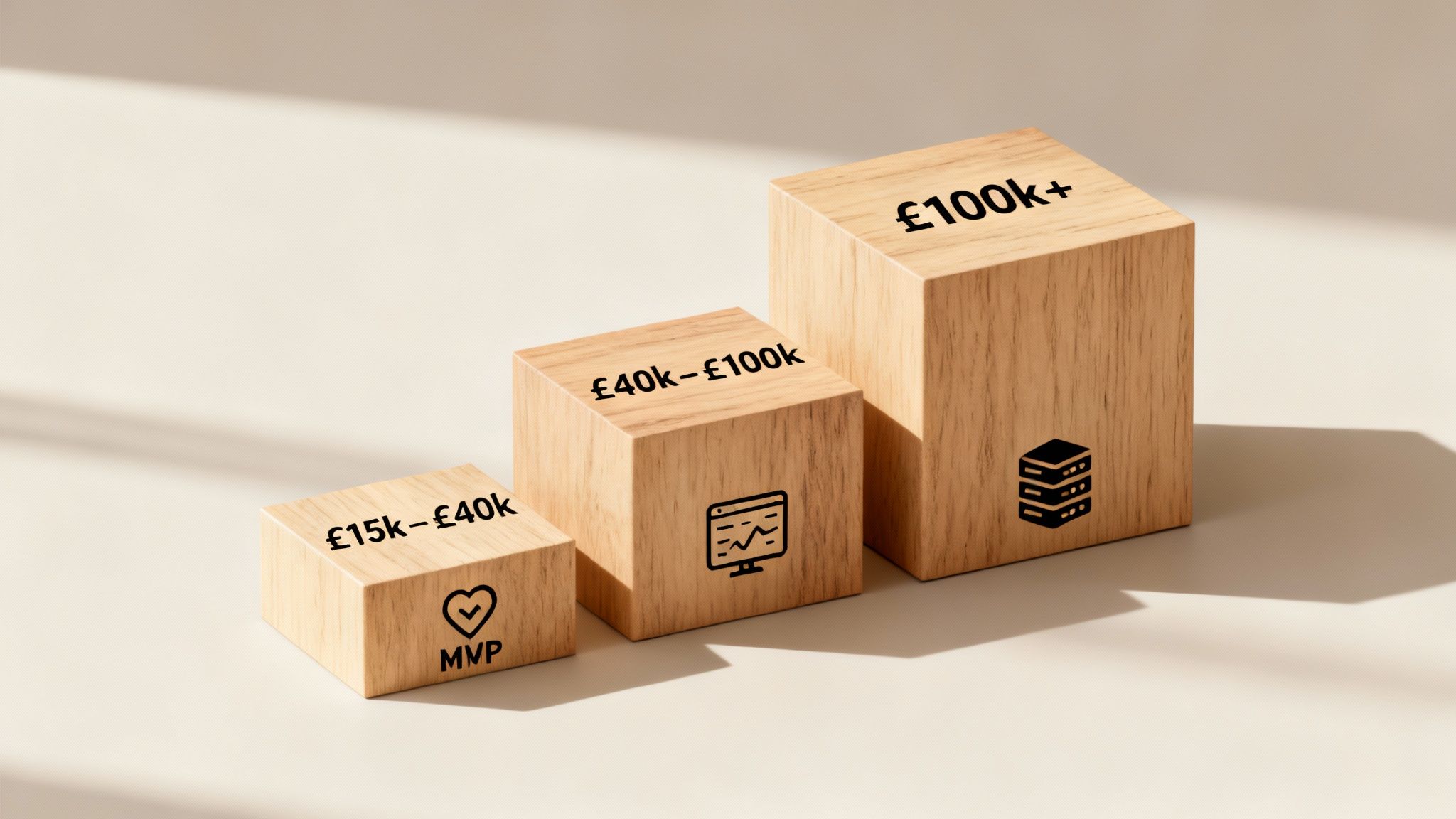
Alright, let's get down to brass tacks. How much does building an app actually cost for a business at your stage? The numbers shift dramatically depending on whether you're a scrappy startup hunting for your first users or an established business needing bulletproof security.
Seeing how these budgets play out in the real world is the best way to anchor your own financial planning. Let's walk through three common scenarios for UK founders to see what you can realistically achieve at different investment levels.
The Lean Startup MVP Build
For an early-stage startup, the name of the game is speed and validation. Your one and only goal is to launch a Minimum Viable Product (MVP) that brilliantly solves a core problem for your target audience. This isn't about bells and whistles; it's about getting a functional product into real hands to prove your concept and gather priceless feedback.
The focus here is entirely on the absolute essentials. Everything else is a distraction.
- Typical Budget: £15,000 – £40,000
- Primary Goal: To validate the core business idea and test market demand before you go all-in with more significant funds.
- Example Features: Your feature list will be ruthlessly prioritised. Think simple user sign-ups, a clean and functional UI, and the one or two key features that deliver your unique value proposition.
This investment gets you a solid, well-built product that’s ready for your first users. It’s the perfect launchpad for attracting early adopters and demonstrating real traction to your first investors.
The Scaling SME Feature Expansion
Once you've got that initial traction and you know your product has legs, it's time to scale up. For a Small to Medium-sized Enterprise (SME), the focus shifts from pure validation to growth, retention, and creating a much more sophisticated user experience. You're moving beyond the basics and adding features that make your app stickier and more powerful.
At this stage, your budget needs to accommodate a more robust architecture that can handle a growing user base. Market analyses show that app development costs are closely tied to business objectives, putting SMEs in a distinct bracket. Apps at this level often need scalable backends and third-party integrations, pushing the budget into the £40,000 to £100,000 range. To see how these figures break down further, you can explore more about app development costs in the UK on ditstek.com.
- Primary Goal: Enhance the user experience, add revenue-generating features, and build a scalable foundation for future growth.
- Example Features: Think about custom admin dashboards, integrating with payment gateways like Stripe, adding social sharing features, or building out more advanced user profiles.
This is where you graduate from a simple app to a polished product that can seriously compete in the market.
The Enterprise-Grade Powerhouse
For a larger business, the stakes are so much higher. You’re not just building an app; you’re creating a critical piece of business infrastructure. The whole conversation shifts towards advanced security, strict data compliance (hello, GDPR!), seamless integration with existing enterprise systems, and rock-solid reliability for a massive user base.
Strategic Insight: At the enterprise level, your app is a mission-critical tool. The investment reflects the need for absolute security, flawless performance, and the ability to scale without breaking a sweat.
- Typical Budget: £100,000 – £500,000+
- Primary Goal: Deliver a secure, highly-scalable, and compliant application that integrates deeply with existing business operations.
- Example Features: We're talking about things like enterprise-grade security protocols, complex API integrations with internal software, advanced data analytics, and multi-layered user permissions.
This level of investment is about building a powerful, long-term asset that drives significant business value and meets the rigorous demands of a large-scale operation.
How To Reduce Costs Without Sacrificing Quality
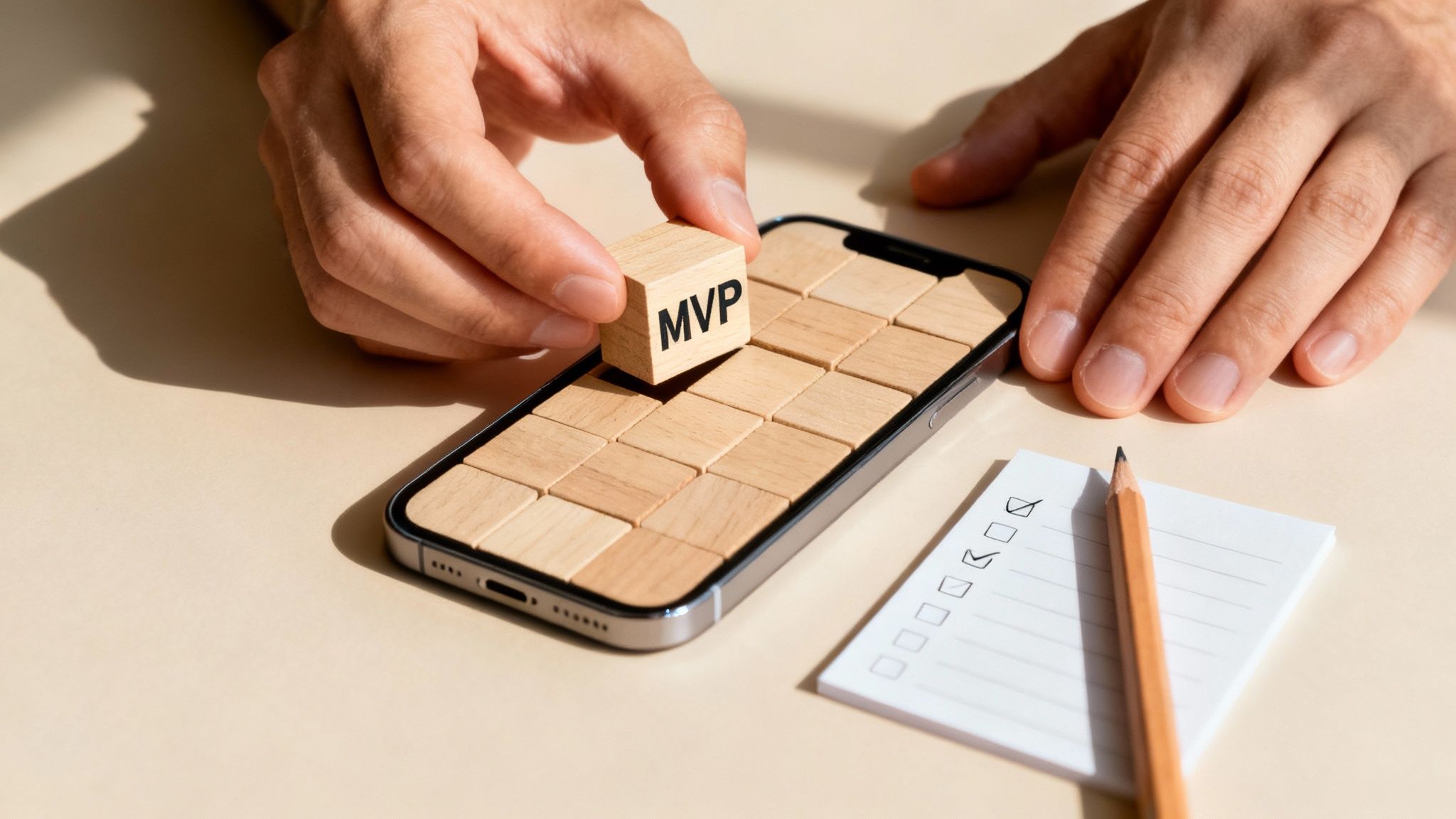
Every founder wants to make their funding go further. The great news? You don't need a bottomless bank account to build a killer app. You just need to be incredibly strategic. Thinking cleverly about how you build is the real secret to keeping your budget in check while still creating something truly special.
Figuring out how much an app costs is just step one. The real magic is in making every single pound work as hard as possible for you. Let’s dive into some practical, battle-tested strategies that will help you launch an amazing product without breaking the bank.
Embrace the MVP Mindset
We've talked about the Minimum Viable Product (MVP) before, and for good reason—it’s the single most powerful cost-saving tool in your arsenal. The entire point is to focus your initial investment on solving one core problem exceptionally well.
Instead of trying to build every feature you’ve ever dreamed of, you build just enough to get into the market and prove people actually want what you're offering. This approach dramatically cuts your upfront costs and, more importantly, reduces the massive financial risk of building something nobody needs.
Actionable Advice: An MVP isn't about launching an unfinished product; it's about launching a focused one. It’s the smartest way to validate your big idea with real users before you commit to a bigger budget.
Choose Cross-Platform Development
Building a separate native app for iOS and another for Android is a fantastic way to deliver a flawless user experience, but it’s also a fantastic way to double your development costs. For most startups, a much smarter move is to use a cross-platform framework.
- What this means: Your team writes one chunk of code that works beautifully on both iPhones and Android devices.
- The benefit: Using frameworks like React Native or Flutter can slash your development time and budget by up to 30% compared to building two separate native apps.
And this isn't a compromise on quality. For the vast majority of apps, modern cross-platform tools deliver a smooth, high-performance experience that users will love, all while getting you to a wider audience, faster.
Plan a Phased Feature Rollout
Your app doesn't need every single feature on day one. A brilliant strategy for managing your budget and cash flow is to plan a phased rollout.
Think of your product roadmap in chapters. Launch your MVP first, then gather real user feedback and data to decide which features to build next. This iterative approach has a few massive advantages:
- It spreads out the cost: You fund development in manageable stages rather than in one huge, upfront hit.
- It’s user-led: You end up building what your users actually want, not what you think they want. This saves a fortune on features that would have just gathered dust.
- It keeps things exciting: Regularly adding new features keeps your users engaged and gives them a reason to keep coming back for more.
Being smart with your budget doesn't mean cutting corners; it means making strategic choices. By focusing on an MVP, using cross-platform tech, and rolling out features over time, you can build an incredible app that makes both users and your investors very ‘appy indeed. 🤓
Let's Turn That Idea Into an App
Feeling fired up? You absolutely should be! Taking an idea from a spark in your mind to a real, working app in someone's hand is an incredible journey. By now, you've got a much clearer picture of what it costs to build an app and the big decisions you'll need to make along the way.
The next step is always the most exciting one: taking action. It’s all about finding a technical partner who doesn’t just understand your vision but is genuinely thrilled to help you build it. You need a team that can move with precision and speed, turning your brilliant strategy into a tangible product.
Your Partner for Launch and Growth
Here at AppyCamper, we've built our whole approach around what founders like you actually need. We know that getting to market fast and validating your idea is everything in those crucial early days.
For startups champing at the bit to make their mark, we’ve created a model designed to get you from concept to a market-ready MVP faster than you thought possible. You can explore our Launchpad programme to see exactly how we help founders get off the ground with a focused, powerful product.
And for businesses that have already found their rhythm and are ready to scale? Our sprint-based Squads provide the dedicated talent you need to level up. We slot right into your existing team to pour fuel on your development fire and tackle your biggest growth challenges head-on.
Ready to Build Something Amazing?
Think of us as the technical co-founders you've been looking for—we’ve got the skills, the ideas, and the drive to help make your app a smash hit. We’re here to be an extension of your crew, bringing the expertise and excitement needed to build a product that works beautifully and leaves everyone ‘appy. 🤓
Ready to find out what’s ‘appening next? Let’s have a chat about your vision.
Got Questions? We've Got Answers
Still have a few things you're mulling over? Perfect. Curiosity is where all the best ideas start. Here are a few of the most common questions we get from founders trying to nail down their app development budget.
How Long Will It Actually Take to Build My App?
Much like the cost, the timeline really boils down to how complex your vision is. There's no one-size-fits-all answer, but we can talk in realistic ranges.
A tight, focused MVP can often be brought to life—from first sketch to launch—in a surprisingly quick 3-4 months. This approach is all about getting to market fast so you can start learning from real users straight away.
If you’re building a more feature-rich app, maybe with a few custom bells and whistles and some third-party integrations, you’re probably looking at a timeline of around 5-9 months.
For the big, enterprise-level behemoths—apps with serious, heavy-duty functionality and complex backends—the journey could easily take 9 months to a year or more. At AppyCamper, our whole model is built on sprints, which means you’ll see tangible progress every couple of weeks, keeping the momentum high and getting you to launch day sooner.
Are There Any Hidden Costs I Need to Worry About?
We're big believers in total transparency, so let's put this one right out on the table. A good development partner will never surprise you with hidden fees. But beyond the main development budget, there are a few other costs you should definitely have on your radar.
- Ongoing Maintenance: Think of this as the cost of keeping the lights on. It’s smart to budget around 15-20% of your initial development cost per year. This covers the essentials like bug fixes, server costs, and crucial updates for new operating systems.
- Third-Party Service Fees: Does your app need a payment gateway like Stripe, maps from Google Maps Platform, or cloud hosting on AWS? These services all come with their own subscription fees, so factor those in.
- Marketing & Getting Users: Let's be honest, building an incredible app is only half the job. You need a separate budget to actually tell people it exists and convince them to download it!
Should I Get Funding Before I Start Building?
For the vast majority of founders, the answer is a huge, resounding yes. Having your first round of funding secured before you write a single line of code puts you in a much more powerful position. It means you have a realistic budget to work with and a proper runway to get your app off the ground.
Investors are going to want to see a detailed plan, complete with professional cost estimates and a clear product roadmap. A really common—and incredibly effective—strategy is to raise a pre-seed or seed round specifically to fund the development of your MVP.
Actionable Advice: This approach is a total win-win. It gives you the capital to build a real, tangible product that proves your big idea has legs. Then, you can use the traction from your first customers as powerful leverage to attract the next round of investment and scale things up. 🤓
We’ve worked with countless founders to shape the technical plans and roadmaps that get investors nodding. It’s all about showing them you’ve got a smart, strategic, and investable plan to bring your vision to life.

